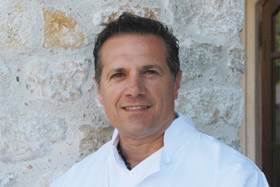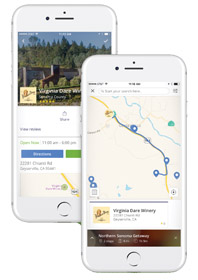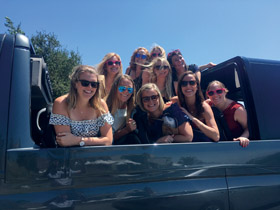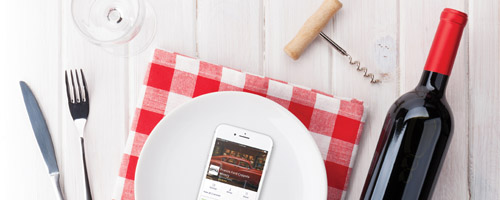
While technology has impacted practically every business and social interaction, wine tasting has remained relatively unchanged. Visitors tend to land in a tasting room either through a recommendation, by seeing a sign or advertisement, or on impulse during an outing. The customer, if they like the wine enough, may join a wine club or at the very least a mailing list, building a relationship between the winery and the consumer. This type of customer engagement has been transpiring in the same way for decades, with little change.
In almost every other consumer product industry, technology allows smaller retailers to compete with big name stores in the online space, and continuing consumer interaction is easy and relatively inexpensive, even while reaching customers from all over the globe.
A local company is aiming to help wineries enter the digital age through developing a new app, called Wine Routes, giving wine consumers a platform to find what they are looking for, and giving wineries a new way to engage and follow up with customers. Furthermore, the platform provides valuable tools for both consumers and brands, supporting the wine experience from exploration and discovery to purchase and retention.
“Small, boutique wineries now have equal footing to reach the consumer when before they just couldn’t compete,” says Adrian Tamblin, founder and chief executive officer of Grapexchange LLC, a Santa Rosa-based technology company that created the Wine Routes app. “With the marketing of wine the smaller brands struggle to get their brands noticed. Wine Routes allows a small producer to tell their unique story.”
The catalyst for the idea came out of Tamblin’s personal frustration in trying to plan wine tasting excursions that fit his desired requirements. Especially when asked by an out-of-town friend to help her plan a trip to the Wine Country, he hit a wall in attempting to plan a route that would meet all her criteria and wishes, and spent hours putting together a plan.
“The idea was conceptualized from my own frustration with planning trips to wineries based on amenities that the wineries had as well as the varietals of wines that they sold,” says Tamblin. “One of the problems I started to see as I looked further into it was a disconnect between the consumer and the brand. There were no useful tools for the end consumer to figure out and plan a trip to wineries. On the flip side of that, what struggles do wineries—especially direct to consumer producers—have, many of which don’t have distributors? Many of the handcrafted wines that consumers seek can’t be found in a restaurant, big box store or local grocery store. It means consumers have to go to the cellar door and visit that location. The challenge for the producer is how to build brand awareness in a sea full of competitors trying to do the same and all making great hand crafted wines. How can they build brand awareness and engage with that consumer pre, during and post visit.”
When Tamblin’s aunt presented him with a customized journal for a birthday several years ago that allowed him to keep track of favorite wineries, wines, and varietals, he had a light bulb moment and the idea for Wine Routes was born.
“On my 30th birthday I was gifted a wine journal and in that journal I could remember the different varietals of wines that I tasted and the different locations that I went to, so I could make better recommendations to my friends,” says Tamblin. “That’s when I thought, there has to be a digital solution to this. I searched and couldn’t find anything online that had to do with trip planning to wineries on scale.”
While Tamblin and his business partner, Ian Scales, found other localized applications, the resources available were static, inadequate and impractical.
“There are winery directories, and there are association maps,” says Scales, chief operating officer of Grapexchange LLC. “There are very localized, very one-trick pony solutions that don’t actually help wineries or users connect, engage, and close the loop from beginning to end.”
Furthermore, many of the winery websites available are not mobile friendly and haven’t been updated to showcase the type of information consumers demand. Many smaller producers are essentially farmers, and not tech-savvy when it comes to on demand information or mobile and website best practices.
After two-and-a-half years of planning and building the platform and interface, Wine Routes officially launched in September, last year. The app helps users plan trips and travel to Wine Country, as well as wine areas and tasting rooms in the United States. Amazingly, there are approximately 4,300 tasting rooms across the country, in all fifty states.
“For the first time wineries can digitize their menu and allow customers to interact with the wines they drink. Wineries benefit by telling the story of each wine, and conversely, consumers get to save the wines they drink back to their personal profile,” says Tamblin.
The social media of wine
Wine Routes’ dual-purpose platform changes the way users interact with the wines and brands they love. The platforms innovative national winery trip planner, coupled with their digital tasting interface provides users with a powerful tool that tracks the wineries they’ve visited, saves the wines they’ve tasted, plans their wine travel, and digitizes the entire experience in one fun easy to use mobile application. The Wine Routes platform will facilitate growth and serve as a direct link between producers and an active community of wine enthusiasts, connecting the two like never before.
“The end user gets to save wines they’ve tasted,” says Tamblin. “If I was in a winery doing a tasting, I could pull up and interact with a digital menu and taste wines in the order they’re being served. Additionally, I could add pre-populated descriptive tags and notes to those wines as I’m tasting them. This serves three purposes. One, I remember what I’m drinking and what I liked and disliked about it. Two, that data is presented in a dashboard to the winery so they understand their consumers’ preferences and three, it connects the consumer to the brand for the purpose of post visit follow up.”
While personal tasting notes and user profiles are kept private, wineries and users can see what wines consumers are connecting with, as well as what wineries they are following and what routes have been completed. Completing the circle is allowing wineries to connect with users post visit.
“Everyone visiting a winery has a phone in their pocket,” says Scales. “They can connect directly through their own device at the bar, on their way out, while they’re driving away, or two weeks later—it doesn’t matter.”
Users can also follow each other. Like any modern social platform, users can “friend” each other and follow each other’s routes. A friend can view a wine route that another friend enjoyed and follow suit. This is especially appealing to the younger generations who put more weight on what their friends recommend, versus what an “expert” might endorse.
“Millennials will take a peer-to-peer review over anything else,” says Scales. “They don’t care what XYZ brand has to say about their own wine, or what somebody who is paid to write reviews about it says. They wouldn’t listen to them about where to have their next experience, they’d rather ask three of their friends to see where they’ve recently been. We want to try to support that new way of thinking about experiencing wine.”
Ease of use
Though Wine Routes has done its best to gather as much publicly available data about each winery, the site will really become a valuable resources as wineries “claim” their profile on the platform and utilize the dashboard on their end to update their amenities, tasting menus and wine details. Consumers can also follow wineries, much like following a business on Facebook, to stay informed about upcoming releases and events.
The ability to quickly and easily update winery information is one factor that makes the wine app appealing to wineries as well as users.
 “[Wine Routes] is a model that is hands-off but yet the winery can manipulate it and make changes and tweak it,” says Henry Belmonte, proprietor and president of Sonoma County-based VJB Vineyards and Cellars and Wellington Cellars. “That was appealing to us. Wine Routes is essentially self-promoting because once you’re on it everybody has the opportunity to see the route that others are taking so you have this marketing mechanism that’s in place. If you wanted to change the marketing mechanism, you can go ahead and do that.”
“[Wine Routes] is a model that is hands-off but yet the winery can manipulate it and make changes and tweak it,” says Henry Belmonte, proprietor and president of Sonoma County-based VJB Vineyards and Cellars and Wellington Cellars. “That was appealing to us. Wine Routes is essentially self-promoting because once you’re on it everybody has the opportunity to see the route that others are taking so you have this marketing mechanism that’s in place. If you wanted to change the marketing mechanism, you can go ahead and do that.”
Conversely, companies that have profiles on websites such as Yelp and Trip Advisor need to contact them to change photographs or content. With Wine Routes, if a winery wants to feature a special on a certain wine or some new event, they can go ahead and do that at any time themselves.
A win-win
While Wine Routes is a free, engaging, user-friendly platform that helps people plan their wine country travel, it’s also a boon for wineries, particularly those that may not have the same brand recognition as the big names that are heavily advertised in the wine industry. Not only will the platform drive customer traffic to their locations that may otherwise not have run across them, but it will also allow the winery to connect with their visitors in an engaging way—both in the tasting room and into the future.
Customers will continue to interact with a winery brand by saving wines and following wineries through the platform. They will stay informed of new wine releases, special offers and events. They will communicate with others through the app about their experiences, and learn of other great wineries to try from their peers. The entire customer interaction process is streamlined into one single platform that unites both wineries and wine enthusiasts.
Bringing wine into the digital age
“We believe we can reduce costs for wineries and increase their consumer exposure, all while providing a state of the art user experience to learn about wine, plan trips, and share their journeys with friends,” Tamblin says.
Wine Routes will bring the wine business—an industry steeped in tradition and old world erudition—into the modern age. Especially since the Millennial generation has been shown to consume more wine as a generation than the generation before it. It understands the importance for the wine industry to keep up with current trends of how the new generations socialize and make purchasing decisions.
 “Smart phones are totally ubiquitous,” says physical therapist Star Stevenson of Santa Rosa who was drawn to the idea of the app, while trying to create wine tasting trips for himself, his friends and his family. “Everybody is using mobile phones. There’s an old-world feel about a winery where you sit down and there’s a winery dog in the room and you begin to sip and share stories. There’s probably a certain amount of people who would love to hold on to that old-world vibe. But, it’s funny. I’m a physical therapist and I have patients now who, even in their 40s, will barely look up from their phones when I’m interviewing them about some serious health issue. What I’ve come to realize is that’s the way it is. People are using their phones for every little thing. Wineries are going to have to embrace people using their phones in the winery—whether they’re scanning the SKU on the back of the bottle, or shooting a picture for them to remember that bottle of wine.”
“Smart phones are totally ubiquitous,” says physical therapist Star Stevenson of Santa Rosa who was drawn to the idea of the app, while trying to create wine tasting trips for himself, his friends and his family. “Everybody is using mobile phones. There’s an old-world feel about a winery where you sit down and there’s a winery dog in the room and you begin to sip and share stories. There’s probably a certain amount of people who would love to hold on to that old-world vibe. But, it’s funny. I’m a physical therapist and I have patients now who, even in their 40s, will barely look up from their phones when I’m interviewing them about some serious health issue. What I’ve come to realize is that’s the way it is. People are using their phones for every little thing. Wineries are going to have to embrace people using their phones in the winery—whether they’re scanning the SKU on the back of the bottle, or shooting a picture for them to remember that bottle of wine.”
While still new, so far users have appreciated the clean looking, intuitive app and have already been busy posting wine routes and travel experiences. Stevenson first used the app to help friends plan a trip to Wine Country, especially for those who had specific requests.
“We had friends—a young couple—who wanted to feature Sonoma County sparkling wines at their Wine Country wedding,” says Stevenson. “Based on their preferences I put together some sparkling wine places for them to visit. Champagne is a little harder to find in the both Napa and Sonoma Counties unless you know what you’re looking for. That was kind of a neat way to use it—especially when you have a specific request like that.”
As wineries continue to see their target demographics changing and becoming more tech-savvy, they must respond to the needs of consumers wanting on-demand information. Wine Routes can supply that instant gratification by streamlining the winery to consumer marketing process and linking consumers to wineries that meet their needs in a quick, easy way.
“As much as I think there’s still a resemblance in our industry of the old world feel when it comes to wine making, the opportunity to market and sell the same product that we’re making in the old world style has changed dramatically,” says Belmonte. “There’s no replacement for somebody coming in here and experiencing our hospitality and that one-on-one, direct to consumer scenario in our facility. But certainly how they find us and what they know about us is in the digital world.”
So, next time you’re up for a day of wine tasting, click before you sip.
Offering Over-the-Top Service with a Casual Style

For those not inclined to a do-it-yourself wine tour, there are thankfully still wine tours operating in the North Bay to suit just about any style and taste. Sebastopol-based Silver Service prides itself on offering a luxury transportation service focusing on small groups, but with a “no jacket required” friendliness.
"Sonoma County is definitely unique," says Steve Thomasson, owner of Silver Service. "We’re so diverse, authentic and genuine. We want to show that off. We’re all about what Sonoma County is about. Yes, we do tours in Napa, but our heart is in Sonoma County,” he says. “After all, it is our back yard. Our service is professional. We open the doors for our guests, and we bring them into the wineries for introductions. That part of our service is over the top.”
Thomasson started the business in 2009 and now has a fleet of four vehicles, all silver of course, because it’s more discreet, stays cooler on hot days, and looks better after a day of touring and tasting along the county’s back roads. Truly meeting any taste or adventure, the vehicle choices range from a Mercedes Benz Sprinter Van with an open retractable roof with 360 degree visibility and a 4×4 powertrain to reach any winery within the foothills, to a Mercedes Benz S63 AMG sedan to a Land Rover LR4 that presents luxury as well as rugged off-road capabilities to roll up a steep vineyard row. The anticipated future addition will include another, larger Sprinter van that will have the capacity to carry up to fifteen people.
Despite his love of cars, however, the business for Thomasson is all about relationships and connecting with customers.
“I love going out every day with the people and showing off where I live,” says Thomasson. “It’s a very competitive business out there and there’s a couple things that make us unique. First of all, I’ve learned that you have to be able to anticipate what kind of experience the guests are looking for. Having the ability to be flexible before and even sometimes, during the tour, is hard to train. Some guests have planned a romantic getaway, while others are excited to hear all we know about the region. Either way, Silver Service prides itself on showing them a great time without being overbearing.”
 Silver Service has also set itself apart, not just by driving silver, versus the traditional black cars, but also in the type of vehicles they offer. The rugged adventure that the Sprinter or the Range Rover beckons is especially appealing to the crowd that wants a unique experience—that wants to be in the vineyards versus just driving by them.
Silver Service has also set itself apart, not just by driving silver, versus the traditional black cars, but also in the type of vehicles they offer. The rugged adventure that the Sprinter or the Range Rover beckons is especially appealing to the crowd that wants a unique experience—that wants to be in the vineyards versus just driving by them.
“They’re four wheel drive,” says Thomasson about most of his vehicles. “I don’t think there are many wine tours that go up in the vineyards or off road. Guests enjoy that—even if it’s just a couple hundred yards to the top of the hill where they can get out and take pictures. They will say ‘I can almost touch the grapes!’ It may sound corny to us, but if you’re from the Midwest that’s exciting.”
Thomasson also has success with what he calls a “cross over tour”—a tour that involves biking along with wine tasting and brings people from the vineyards to the redwoods and to the coast to really showcase all the beauty Sonoma County has to offer.
A pre-tour questionnaire allows Thomasson to create a wine tour to suit his customers’ wishes and ensure a memorable day. “You need three things to make a good wine experience,” says Thomasson. “First, good wine. Second, a unique venue—it doesn’t necessarily have to be fancy—it could be a funky warehouse or a terrace overlooking the Laguna, and last, hospitality. Silver Service offers all that. We want our guests to be as comfortable with us as they would be in their own back yard.”
How to Claim Your Winery
For winery owners to claim their winery on Wine Routes, they must sign up for a user account at wineroutes.com/signup. Once they verify their user account, they can head over to wineroutes.com/businesses or follow the “Claim Your Winery” link in the footer of the Wine Routes website.
On the business page, wineries can search for their winery by name and request to claim it. Once the request is approved they will be sent an email, giving immediate access to their winery dashboard.
Once their winery is claimed, wineries can manage their profile on the dashboard. They can edit information about their tasting room, add full wine profiles, build interactive tasting menus, and create image galleries to show users what makes them unique.




